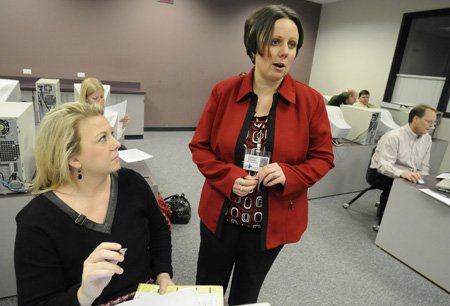ROGERS — Ashley Daniel has helped teachers and administrators become data analysts in her three years at the Rogers School District.
They use data to track students’ progress and judge the merits of various programs. They identify students who, with just a little extra help, can pass important tests.
Daniel, the district’s director of data and accountability for three years, said the district has made major progress in its approach to data, and she expects the use of data in the schools to continue growing.
Daniel said she often had to find work for herself when she first started the job, she said. District employees asked for basic help, she said, such as how to find data.
“Now it’s ‘I want to know how my special education students are doing that were here in 2006,’” Daniel said. “They’re really getting deep into the data.”
Daniel is a new kind of school administrator, born in part out of No Child Left Behind, which requires some tracking of progress, said Ronna Turner, one of Daniel’s former professors at the University of Arkansas.
Daniel and others like her have the skills to track progress and create statistical models, rather than just take a snapshot of students’ abilities at a given time, Turner said.
That means schools and parents can get an accurate idea of the schools’ effectiveness, said Sean Mulvenon, director and founder of the National Office for Research Measurement and Evaluation Systems, or NORMES, at the University of Arkansas.
The district keeps track of a multitude of data points for every student, such as demographic information, academic performance and attendance. The trick is accessing and analyzing the information, Daniel said.
She creates reports upon request for teachers and principals. It’s common for Daniel to create a custom report for one teacher, then get requests for similar reports at other schools, she said.
Daniel studied math and statistics before switching to educational statistics and working with NORMES.
One of the goals of the office is to get people like Daniel into school districts, Mulvenon said. The Fayetteville and Bentonville school districts also employ NORMES-trained data analysts, Mulvenon said.
Daniel said she prefers the application of statistics instead of studying theory. The district’s students are numbers to her, but the use of data can have real consequences, she said.
Daniel recalled a principal thanking her for help determining how to meet adequate yearly progress, a requirement from No Child Left Behind. She identified students more likely to fail standardized tests and what the school could do to help them.
“When there are moments like that, it’s all worth it,” she said.
Daniel heads a data team that meets monthly. The members discuss everything from reading programs to individual students.
Jennie Rehl is the principal at Grace Hill Elementary School and a member of the data team. Daniel has changed the way the district operates, Rehl said.
“For so long we followed our gut — what we call our gut or our heart — and that’s lovely,” Rehl said. “But now we’re making data-based decisions on what to do for the child.”
Web Watch
National Office For Research On Measurement And Evaluation Systems
normes.uark.edu

